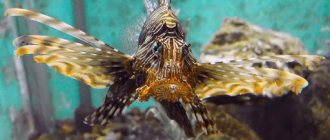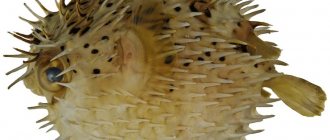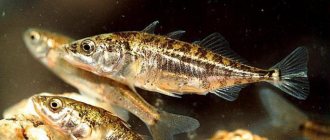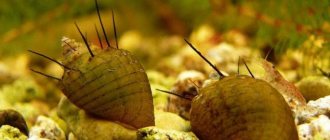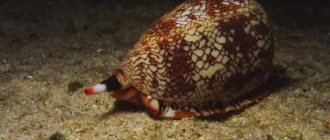№1
The fish Eviota sigillata has the shortest lifespan of any vertebrate on the planet. The lifespan of Eviota sigillata is only 59 days.
It grows to only 1-2 cm in length. She reaches sexual maturity at 25 days and until the end of her life, female fish lay about 400 eggs.
Once the eggs hatch, the fry take about three weeks to become adults. That is, they spend about 1/3 of their lives on this.
Interesting facts about fish
Amazing facts about fish are interesting for both children and adults, because looking beyond standard concepts about ichthyofauna is very useful and educational.
"Blind" fish
This fish lives in underground reservoirs in Mexico. This fish is called blind because its eyes are closed by a skin growth, which means that under no circumstances can it see anything. The fish gets along well with its own adaptations, which Wise Nature has provided for it. She has a very well developed sense of touch and smell. In addition, the lateral line helps her a lot, especially that part of it that is located on the head.
Blind fish (Anoptichthys jordani) found in underground reservoirs in caves in Mexico
Jumping fish
In the waters surrounding the Galapagos Islands, there is a fish called the Galapagos dialoma . From time to time, when the sea tide reveals the underwater rock labyrinths in which the Galapagos dialoma “lives”, it gets out of the water and begins... to jump. But the ability to jump is not the only hunting adaptation. Nature has awarded this fish the ability to change color. But that's not all. She has the gift of double vision. A septum passes through her pupil, which allows her to see both in water and in air. Wise Nature, as always, has provided for everything.
Galapagos dialoma
Curious fish
Stromateus fish swims off the coast of Indonesia - a highly curious creature. Indonesian fishermen use this quality to their advantage. It all happens roughly as follows. Take a bamboo pole. One end of it is lowered into the sea, and a crossbar is strengthened at the other end. One of the fishermen stands, leaning his chest on the crossbar, and as slowly and monotonously as possible begins to chant: “Oh-oh!” Stromateus, overcome by curiosity, swim up to the boat. Sometimes they lose control of themselves so much that they jump out of the water, jumping up to the faces of the fishermen. And that’s all the fishermen need.
Stromateus fish
Flounder eyes
Eyes are just eyes, nothing special. It’s just that both eyes are located on one side of the body - on the top. This is more convenient for fish that lie on the bottom. But the most amazing thing is that the flounder is born with a normally located organs of vision. But as the flounder larva grows, it becomes more and more asymmetrical. The larva does not lie on the bottom, but floats with the current. In this case, one side of the body develops much more strongly, the eye “moves” to the other side, and the body becomes flat. And as soon as the larva finally turns into a fish, it stops traveling and lies on the bottom of the sea.
Flounders are a family of ray-finned fish of the order Flounders.
Does caviar “grow” on trees?
It is known that caviar does not grow on trees, but Alaskans collect herring caviar from tree branches. Egg collectors lower branches into the water before spawning and remove them after spawning. Herring lay eggs, attaching them to submerged branches.
What kind of fish can you make files from?
Residents of some Pacific Islands use shark skin to make files that can be used to polish wood and even marble.
Shark skin under a microscope resembles sharp teeth
What is made from catfish swim bladder?
European catfish is a rather lazy fish. Unless absolutely necessary, he does not make unnecessary movements. This causes the fish to grow quickly. The largest individuals live in the Amazon River basin and in European rivers. A fish 5 meters long and weighing 306 kg was caught in the Dnieper. And glue is made from catfish swim bladders.
Who are the Hauliods?
Howliods are mysterious, luminous creatures with wide mouths and long stomachs. They are often called viper fish or viper fish. Despite their small body size, they are ferocious and bloodthirsty predators. They search for prey using excellent vision. It is believed that large, silver-rimmed eyes see in murky water 30 times better than human eyes. All luminous organs of the hauliod are specialized glands. There are more than 1,500 complex photophores on the body. The organs of luminescence are extremely efficient - they convert 98% of energy into light, while an electric light bulb converts 4% of electricity into light and releases the rest as heat. If you touch a fish, its entire body will begin to sparkle with a wonderful pulsating light.
Hauliod is a typical inhabitant of the depths
Can fish fly?
Flying fish live in the tropical seas of the World Ocean. They are desirable prey for many predatory fish, such as tuna and sharks, as well as seabirds. The tail of a fish preparing to take off makes about 50 beats per second. A flight distance record was recorded: in 42 seconds the fish covered a distance of 600 meters. Pectoral fins - the wings of a flying fish are located above the center of gravity and make up 70-80% of the total length of the fish’s body. Flying fish are found on ship decks located at a height of 10 meters from the surface of the water - they are carried there by a tailwind. Usually they do not rise above the water more than a few tens of centimeters.
A distinctive feature of flying fish is their long pectoral fins, which allow the fish to glide above the surface of the water.
Who is called the “white death”?
Carcharodon, which is called the “white death”, lives in all warm seas. Most often, it is this shark that attacks a person and even “attacks” boats with people. They squeeze the victim with a pressure force of several tons per square centimeter. The shark does not have a swim bladder; therefore, to provide itself with oxygen, it constantly swims at an average speed of 3.5 km/h. Spend most of your time alone. The white shark is a viviparous fish. The female gives birth to one, less often two, cubs per year.
The white shark is the largest predatory fish
What fish can talk?
The amphibians of our planet - toads - have found “relatives” in all oceans except the Arctic Ocean - toad fish (opsanus). These poisonous fish are really very similar to toads: they have the same rough skin (opsanus have no scales), large bulging eyes, a large mouth, etc. The peculiarity of toad fish is that, unlike other fish, they can “speak”, although at the same time they emit very sharp and extremely unpleasant sounds, reminiscent, according to eyewitnesses, of the whistle of a large ship. Toad fish emit unusually loud sounds, which can even harm a person’s hearing, when they want to inform others that a convenient territory has already been chosen for living, and not by anyone, but by them.
What fish is considered a sniper?
The rivers and seas of Southeast Asia are home to an amazing fish - toxotes, which is better known as the shooter fish or the spray fish. The aquatic inhabitant received this name for its amazing ability to shoot a stream of water from its wide mouth so as to accurately hit its intended target - various flies, midges and other insects.
Having filled the mouth with water, the toxotese presses its lips tightly, and then, making a tiny hole, pushes the water through it with its tongue. As a result, a gaping insect, peacefully dozing on a leaf of a coastal plant, ends up in the voracious mouth of a diving fish. Also, with the help of a water jet, Toxotes “shoots” into the watery soil, “exploding” it in order to discover prey underneath it.
What fish can't swim?
In the darkest depths of the world's oceans lives the mysterious pipistrelle fish, which is famous for the fact that, although it is a fish, it nevertheless cannot swim at all. In general, this is not surprising: there are birds in nature that cannot fly - ostrich, kiwi, etc.!
The pipistrelle, unable to swim, nevertheless does not remain motionless: its rather strong fins quite successfully replace the legs of this fish, so it practically “walks” along the bottom. However, it should be noted that he does this with great reluctance and difficulty, and therefore most of the time he prefers not to move, disguising himself as some underwater pebble and waiting for the ingenuous aquatic inhabitants. For a successful hunt, the pipistrelle fish has a very convenient “device” - a special fishing rod (ilicium) with a “flashlight” at the end.
Why was the fish called a rag?
The Pacific Ocean is home to a wide variety of, often quite outlandish, fish, but the rag fish, whose body is obedient and very sluggish (it even wrinkles like a real piece of fabric), occupies a special position. This loose fish lives at the very bottom and has a very soft skeleton, making it completely shapeless. It is surprising that this fish gradually becomes a “rag”: from a normal creature “living” in the upper layers of water, it turns into a vague and indefinite creature, and then sinks to the bottom. It is surprising that ichthyologists still do not understand the reasons for such mysterious metamorphoses of this fish.
Fish that looks like a pterodactyl
In some seas of our planet you can find a mysterious fish, whose highly elongated jaws make it very similar to ancient flying lizards - pterodactyls. This fish is called a garfish and is amazing, in addition to its memorable appearance, because it can “dance” above the surface of the sea. From time to time, jumping out of the water - either in order to catch a gaping insect, or trying to avoid danger in the water - garfish perform a real dance, twisting and turning in all directions. Interestingly, garfish have an insidious surprise in store for fishermen who are lucky enough to get this fish out of the water: when cooked over a fire, the bones of a garfish for some reason acquire a distinct green color, which immediately deprives everyone who has gathered to feast on this fish of their appetite.
№3
Although almost all fish have a tongue in their mouth (with a few exceptions), they do not use it to create sounds. To create sounds, language alone is not enough. A well-developed larynx is also needed. The fish's tongue is used to push food through.
However, even though they don't use language to make sounds, that doesn't mean they don't communicate with each other.
They use various low sounds to convey messages to each other. They wheeze, hiss, whistle, moan, etc. But to create sounds, they do not use vocal cords (since they simply do not have them), but their swim bladder.
Fish don't have ears.
0
But they have an inner ear, which is a bone that serves to perceive sounds and vibrations of water. Smell and taste also come to the aid of fish, which allow them to navigate the chemical composition of the environment. The ability of fish to sense chemical signals is well illustrated by salmon, which, when going from the sea to river systems to spawn, determine by the smell of the water exactly the stream or river in which they themselves once spawned.
№7
One of the most amazing fish on the planet is the Mudskipper. They not only swim in water, but can also live on land.
Like other fish, they use gills to breathe underwater. If the gills dry out, they will stick together and the fish will never be able to breathe again. To counter this, mudskippers pump water into their gill chambers, which keeps them moist and prevents them from drying out.
When they go out onto land, they breathe using their skin, just like frogs do.
Fish can fly.
0
Of course, not all, but about 50 species really do. These are the so-called flying fish, capable of reaching a speed of 60 kilometers per hour under water and crossing its surface, rising to a height of up to 5 m. In most cases, the soaring flight range of these fish is about 50 m, but they are able to use air currents above the water, increasing the flight range to 400 m. Flying fish are unable to control their flight, so it is not uncommon for them to crash into the side of a ship or fall onto the deck.
№8
As we know, they are both marine and freshwater. And in this regard, there is a significant difference between them. While saltwater fish drink water constantly (with the exception of sharks), freshwater fish hardly drink it. It's all about the concentration of salt in the water.
The concentration of salts in the body of freshwater fish is higher than in the water around them. Therefore, water is easily retained in the body of freshwater species. Moreover, if a sufficiently large amount of water gets into such a fish, it can swell and die.
With sea fish the opposite is true. The concentration of salts in her body is lower than in the surrounding water. Therefore, osmatic pressure causes water to be regularly removed from her body. This poses a risk of dehydration. To prevent this from happening, they drink water.
Puffer fish can inflate into a ball.
0
Puffer fish from the pufferfish family can increase in size in a stressful situation. And quite strongly - 2-3 times. This fish has a very elastic stomach and is able to quickly swallow large amounts of water and even air if the situation requires it. Pufferfish in this form are practically invulnerable. It happened that large predatory fish tried to swallow such a ball, and in the end they were found dead with the victim stuck in their throat. Many members of the family are poisonous. Their bodies produce a toxic substance called tetrodotoxin, which is deadly to humans and up to 1,200 times more poisonous than cyanide.
Most fish are cold-blooded
Like amphibians and reptiles, to which fish are distantly related, the vast majority of fish species are cold-blooded: they depend on the temperature of the environment (water) to maintain their internal metabolism. However, barracudas, tuna, mackerel and swordfish - all belonging to the suborder mackerel - have a warm-blooded metabolism, although it is quite different from that of mammals and birds. Tuna can maintain a core body temperature of 32 degrees Celsius, even when swimming in 7 degree Celsius water!
Mako sharks are also warm-blooded, which gives them extra energy when chasing prey.
There are three classes of fish
Fish are divided into the following three main classes:
1) Ray-finned fish (Actinopterygii) - the most diverse class, including more than 20,000 species of fish known to science;
2) Lobe-finned fish (Sarcopterygii) - a class of bony fish, to which the genus of ancient fish - coelacanths - belongs;
3) Cartilaginous fish (Chondrichthyes) - a class that includes such well-known fish as sharks and rays, as well as chimeras.
About sharks
The most famous cartilaginous predators are sharks, but despite this, the facts about them are very interesting. For example, these fish almost always feel hungry. They can eat anything they see, even their own entrails that fall out of their torn stomach.
In the belly of this predator, strange things have been discovered more than once that do not harm it. These include suitcases, horseshoes, and pots.
The structure of the shark is also of interest. Her jaws and skull are not connected to each other, so if necessary, for example, before a bite, she moves them forward. In addition, they have no bones at all.
Male blue sharks bite females during courtship, which is why their skin is three times thicker than that of males.
Fishes of the seas and oceans
Sea bass
A deep-sea predator with bulging eyes, it lives in the waters of the northern hemisphere of the Pacific and Atlantic oceans. The color is most often red-pink, but there are also other colors - blue-green, dark gray, it depends on the habitat. Ichthyologists believe that some species of sea bass can live even 200 years! At the same time, the growth rate of these fish is slow - the largest, the Bering Sea fish, reaches a length of 1 meter and a weight of 20 kilograms. Some species of sea bass, like sturgeon, are listed in the Red Book.
Tuna
50 subspecies of fish are united under this name. Therefore, the length of tuna can be either 30 centimeters or almost 5 meters and weigh up to 600 kilograms! Life expectancy is also different - from 3 to 50 years. Schools of these predatory fish can travel long distances in search of food in the Indian, Pacific, and Atlantic oceans, accelerating to a tremendous speed of 90 km/h. Gourmets value the meat of this fish for its excellent taste and nutritional qualities. However, ichthyologists and ecologists are calling for a refusal to consume tuna, as many species are now on the verge of extinction due to large-scale fishing and environmental deterioration.
Dorado
A muscular predatory fish with strong scales, diving to a depth of 150 meters in pursuit of its prey, lives in the Mediterranean Sea. The ancient Romans used this fish for breeding in their aquariums. It was believed that dorado brings good luck and prosperity to a young family, so it was customary to cook it for wedding feasts. Now small specimens are sold in markets, which are prepared without cutting, but only by removing the entrails. Average life expectancy is 10 years. During this time, the dorado can grow up to 70 centimeters and weigh more than 15 kilograms.
Mackerel (mackerel)
This fish lives in schools, traveling long distances. Mackerel is a heat-loving predator; it feeds on plankton and small fish; in search of food it passes through the waters of all oceans except the Arctic Ocean. The average length of a markel is 30 centimeters with a weight of 300 grams, but sometimes fish are found that are three times the average size. Mackerel is highly valued in cooking because it can be prepared in many ways and is also very tasty and healthy.
Herring
Several species of fish fall into this category, and all of them are caught on an industrial scale. Most species of herring live in the temperate waters of the Pacific, Atlantic and Arctic oceans, but schools rarely swim close to the shores. By the way, there is freshwater herring, it is found in the waters of the Dnieper, Volga and Don. Sea herring reaches an average length of 40-50 centimeters. Pacific water is especially valued because it contains a lot of useful element - iodine.
Pisces are unable to blink
One of the anatomical features that makes the fish a little strange is the lack of eyelids, and therefore their inability to blink: the mackerel's gaze will remain the same glassy, regardless of the relaxed or anxious state of the fish. In this regard, the logical question arises, does the fish sleep? Despite constantly having their eyes open, there is some evidence that fish do sleep, or at least exhibit restorative behavior similar to human sleep: some fish slow their swimming pace, and also hide under rocks, coral and algae.
Even when the fish are completely motionless, underwater currents still supply the gills with vital oxygen.
Fish are oviparous, not viviparous
Unlike other vertebrates, most species of fish fertilize their eggs (eggs) externally: the female lays hundreds or thousands of small, unfertilized eggs, and the male at this moment releases his sperm into the water, thereby fertilizing the eggs. Some fish are characterized by internal fertilization; males use their penis to transfer sperm into the female.) There are exceptions: ovoviviparous fish, the fry of which emerge from eggs in the female’s body, as well as viviparous fish, for example, the lemon shark, which has an organ very similar to the placenta of mammals .
Famous fishing records
One of the most expensive aquarium representatives is the dragon fish, which costs 80 thousand dollars, but it is surpassed by the platinum arowana with a price of 400 thousand dollars per individual.
Representatives of the ancient world are coelacanths and coelacanths - copies of primitive prehistoric fish.
The blue whale, which is larger in size than all animals in the world, is considered a giant mammal. Its size reaches 33 meters, and its weight is 150 tons; small herring or trout can swim in its blood vessels; the diameter of the aorta is 25 cm.
Electric stingrays are known for having the largest number of taste buds - 27 thousand, while humans have only 7 thousand.
In 1989, a record-breaking beluga with a length of 6 meters was caught in Russia. The pike caught in the Tsaritsyn ponds near Moscow is considered to be long-lived; a gold ring with an engraving of Boris Godunov was found in its gills, which made it possible to establish its age at 200 years.
Unbelievable but true
It is worth paying attention to other interesting facts about fish that seem incredible at first glance. So, it is known that these creatures can also drown. If there is a small amount of oxygen in the water, the fish may suffocate, since air is important for its life.
There is a very unusual subspecies in the imperial angel family. Males have several wives. But if he dies, a female takes his place. The most amazing thing is that she changes her gender to lead the “harem”.
Fish were the first vertebrates on the planet
Before the emergence of “true” vertebrates, there were chordates - small marine animals with bilateral symmetry, as well as a primitive nervous system running along the length of their body. A little over 500 million years ago, during the Cambrian period, a population of chordates evolved into the first true vertebrates, providing the foundation for the reptiles, birds, amphibians and mammals we all know and love.
The largest of the 6 major groups of animals, invertebrates have followed their own evolutionary path and today they make up a whopping 97 percent of all fauna species.
Perhaps fish can feel pain
Even people who advocate more humane treatment of “higher” vertebrates like cows and chickens are tight-lipped when it comes to fish. But there are some controversial studies suggesting that fish can feel pain, even though they lack the brain structure associated with pain like mammals. In England, the Royal Humane Society passed a resolution against cruelty to fish, which supposedly applies more to mutilations from fishhooks than to industrial fish farms.
